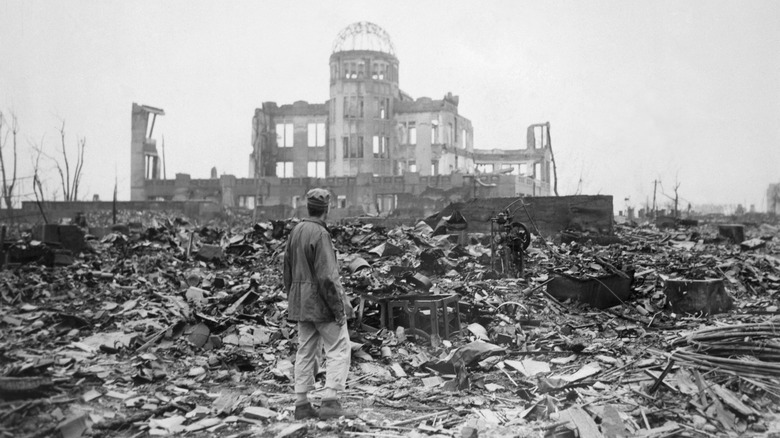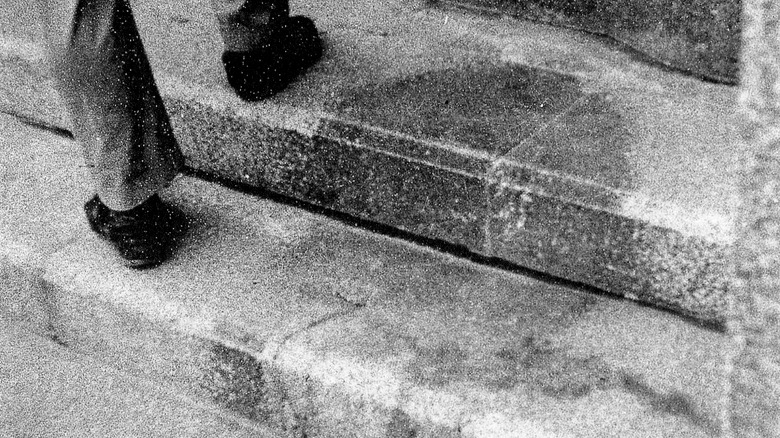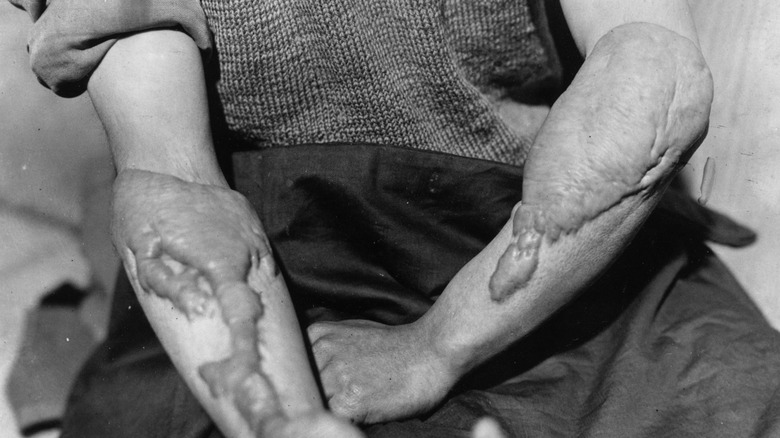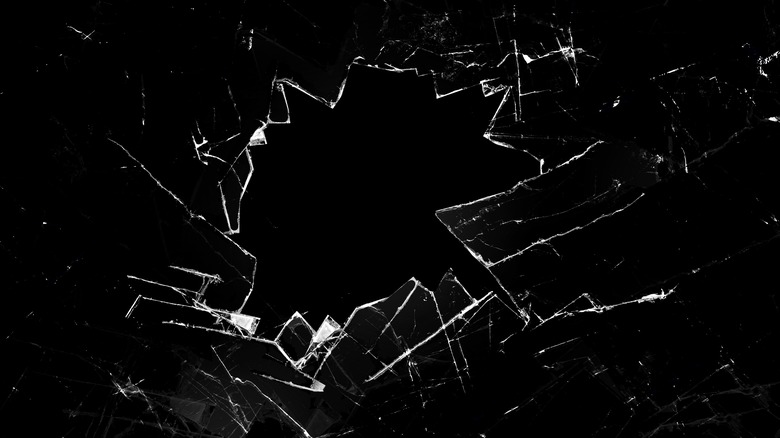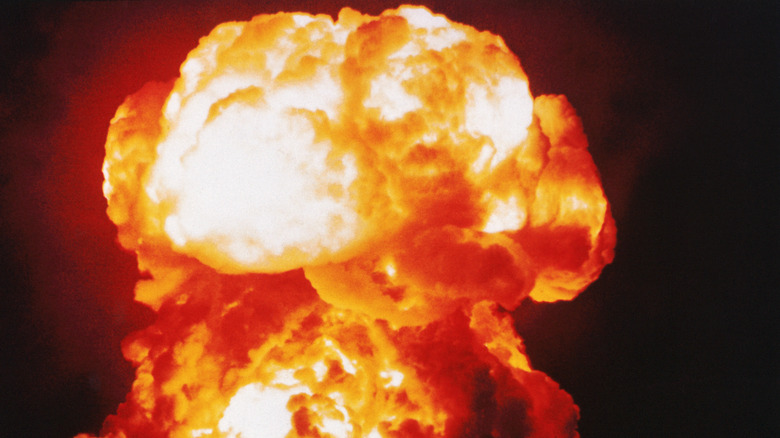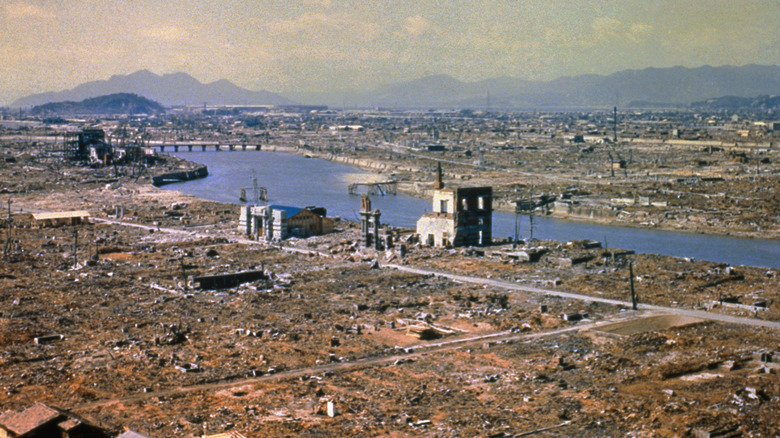What Happened To People's Bodies When The Hiroshima And Nagasaki Bombs Exploded?
The men who dropped the atomic bombs on Hiroshima and Nagasaki in 1945 couldn't comprehend the devastation they had unleashed, not on a human scale. Flying overhead, they could perceive the immense mushroom clouds. Hours later, the smoke was still too thick to see anything below. Photographs taken from above when the air was clear showed how much of both cities had been leveled, but still didn't convey the cost of human life. Before the bombs were detonated, early estimates anticipated casualties in the neighborhood of 20,000. The actual death toll, around 140,000 for Hiroshima and 70,000 at Nagasaki, was an unsettling realization for both President Harry Truman and J. Robert Oppenheimer.
The victims had their own limits of perspective. The fires obscured their vision, and the extent of the damage was so vast that many surviving eyewitnesses to Hiroshima were aghast when they learned that a single attack was responsible for so much destruction. But there was no question of the horrors of the atomic bomb for those caught in its wake. Thousands were killed instantly at Hiroshima and Nagasaki, and thousands more would endure months, years, even decades of agony directly or indirectly caused by the bombings.
Survivors have shared their stories of how the atomic bomb impacted their lives over the years, from the scars to the impact on their worldview. The immediate effects of the bombs on their bodies, and on those of the dead, are no less unsettling than the long-term consequences and have had a serious impact on assessments of both attacks.
Many bodies disappeared altogether after the bombs fell
Among the most haunting images to come out of the bombings of Hiroshima and Nagasaki is the "shadow" of one of the victims, etched into the stone steps of the Sumitomo Bank in Hiroshima. The explosive — Little Boy — detonated several hundred feet above ground, and the radiant heat of the blast was intense but brief. It scorched anything in a direct line, bleaching exposed surfaces that survived. But if an area of those surfaces was shielded — by a human body, say — that area remained dark. Meanwhile, the human being who once sat on the steps of Sumitomo Bank was so thoroughly destroyed that they and scores of others have been described as vaporized.
There's a misconception that comes from the term "vaporized" in relation to the atomic bomb. It's not possible to completely obliterate every last bit of tissue from a living thing, even if the temperature flares up to 7,000 degrees Fahrenheit due to a nuclear blast. There would be remains, though they may be reduced to ash. But up to 80,000 people are estimated to have died instantly from the initial explosion of the bomb dropped on Hiroshima, and around 40,000 from the explosive dropped on Nagasaki. Significant numbers of those who were up to half a mile from ground zero were fated to become ashes. Such complete destruction is among the reasons the death tolls from the atomic bombs can never be known for certain.
[Featured image by Matsuhige Yoshito via Wikimedia Commons | Cropped and scaled]
Flash burns caused death and misery in both cities
One of the greatest hazards of a nuclear explosion is the risk of flash burns. They're caused by intense exposure to high voltage electricity or thermal radiation. A distinguishing feature of atomic bombs compared to conventional weapons is that so much light and heat is put out that direct exposure can cause serious injuries even to people far removed from ground zero. Flash burns are limited to those areas of skin that aren't shielded from the light and heat of the explosion, but victims of the Hiroshima and Nagasaki bombs suffered third-degree burns as far away as 5 miles from the detonation site.
Japanese assessments of the bombings claimed that flash burns caused visibly reddened skin on victims almost instantaneously. Photographs of survivors show strikingly sharp lines separating injured from healthy tissue; clothing was enough in many cases to provide cover from the intensity of the light. In other cases, the color of the fabric affected how protected the victims were. One individual wearing a striped black-and-white shirt had their skin sheltered by the white stripes while the black burned away.
Many people were shredded by debris and shrapnel
Rikuko Sasaki was a schoolgirl when the atomic bomb was dropped on Hiroshima. In an account she later gave to Memories of Hiroshima and Nagasaki, she described cleaning up at school as the air raid sirens sounded outside when the flash of the bomb's explosion went off. The school shook as the blast shattered windows, broke the blackboard, utterly destroyed the neighboring classroom, and tore the roof off the school. Sasaki sheltered under her desk when the bomb went off. When she came up, she saw her teacher, Ms. Yamanaka, torn up by the broken glass from the windows. Her face was bleeding, and shards of glass were embedded in her body. Sasaki pulled out the glass and cleaned up Yamanaka with a first aid kit.
Similar stories occurred throughout Hiroshima and Nagasaki, where one of the most immediate dangers after the detonation of the bombs was shrapnel and debris. The blasts damaged or destroyed virtually all windows in both cities and broke doors and ceilings of various materials. Falling debris is estimated to be responsible for 30% of deaths at Hiroshima and 9% at Nagasaki. Deaths and injuries from shrapnel extended 10,600 feet out from ground zero at Hiroshima and 12,200 feet from the same at Nagasaki.
Debris wasn't only a problem in the immediate aftermath of the blast. Survivors said pieces of glass that had been embedded into their bodies in the explosion later grew out of their skin.
Victims suffered flash blindness from the explosion
Some eyewitnesses to the detonation of the atomic bombs over Hiroshima and Nagasaki saw little or nothing else afterward. The initial flash of light caused by a bomb detonation is so intense that the retinas in the human eye cannot handle it. Direct exposure to such a brief, intense light causes flash blindness. It's a danger even to those shielded from the heat and percussive force of the explosion.
A direct look into the detonation of a bomb like the one dropped on Nagasaki can lead to permanent vision loss for those up to 4 miles away in daylight. At night, with the pupils dilated to let in more light, that range increases to 25 miles. Less direct views of the flash can be less damaging but still result in temporary or permanent blindness. The bombs used on Hiroshima and Nagasaki were dropped during the day, which likely spared many survivors from significant optical damage. Even so, people who beheld the flash of the explosion suffered flash blindness for anywhere between several minutes and three hours.
There was no formal count of people permanently blinded by Hiroshima and Nagasaki. It may be that few of the survivors looked directly at the explosions. The U.S. military later conducted experiments on flash blindness from nuclear explosions on its own soldiers in the 1950s.
Water might have exacerbated conditions for the wounded and dying
Water was no comfort to those burned by the fires set off by the bombs at Hiroshima and Nagasaki. A nuclear explosion radiates surrounding water, and any spray falls back down to Earth as a nuclear shower. Rain falling after Hiroshima was blackened by soot and ash and carried with it debris from the explosion as well as radioactive material.
For victims of the burns, intense heat, and injuries, even contaminated water may have been seen as a blessing. A common refrain in survivors' accounts is how the wounded and dying begged for hydration. But even before the atomic bombs fell, the military had advised that people with such injuries should not be given anything to drink. This is still recommended for certain injuries. In a case of severe bleeding, taking in water can exacerbate blood loss. And when the extent of bleeding couldn't be determined, it would have been difficult for anyone without medical training to assess if a victim could handle water. If they were already on the brink of death, a drink likely wouldn't have made a difference.
Making judgment calls in that situation haunted many survivors. Rikuko Sasaki recalled seeing a neighbor try and get water out of an ice pack that his mother kept away from him. When the boy died, his mother couldn't stop crying or giving his dead body water. Other survivors reported giving drinks to victims who then died, or being too injured themselves to provide hydration to begging, dying children.
